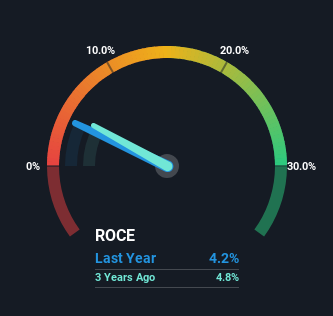- France
- /
- Healthcare Services
- /
- ENXTPA:GDS
Returns On Capital At Ramsay Générale de Santé (EPA:GDS) Paint A Concerning Picture
Did you know there are some financial metrics that can provide clues of a potential multi-bagger? One common approach is to try and find a company with returns on capital employed (ROCE) that are increasing, in conjunction with a growing amount of capital employed. Basically this means that a company has profitable initiatives that it can continue to reinvest in, which is a trait of a compounding machine. Having said that, from a first glance at Ramsay Générale de Santé (EPA:GDS) we aren't jumping out of our chairs at how returns are trending, but let's have a deeper look.
What Is Return On Capital Employed (ROCE)?
If you haven't worked with ROCE before, it measures the 'return' (pre-tax profit) a company generates from capital employed in its business. The formula for this calculation on Ramsay Générale de Santé is:
Return on Capital Employed = Earnings Before Interest and Tax (EBIT) ÷ (Total Assets - Current Liabilities)
0.042 = €225m ÷ (€6.9b - €1.5b) (Based on the trailing twelve months to December 2023).
Thus, Ramsay Générale de Santé has an ROCE of 4.2%. In absolute terms, that's a low return and it also under-performs the Healthcare industry average of 8.6%.
View our latest analysis for Ramsay Générale de Santé

Historical performance is a great place to start when researching a stock so above you can see the gauge for Ramsay Générale de Santé's ROCE against it's prior returns. If you're interested in investigating Ramsay Générale de Santé's past further, check out this free graph covering Ramsay Générale de Santé's past earnings, revenue and cash flow.
What Does the ROCE Trend For Ramsay Générale de Santé Tell Us?
When we looked at the ROCE trend at Ramsay Générale de Santé, we didn't gain much confidence. Over the last five years, returns on capital have decreased to 4.2% from 5.9% five years ago. Meanwhile, the business is utilizing more capital but this hasn't moved the needle much in terms of sales in the past 12 months, so this could reflect longer term investments. It's worth keeping an eye on the company's earnings from here on to see if these investments do end up contributing to the bottom line.
On a side note, Ramsay Générale de Santé has done well to pay down its current liabilities to 21% of total assets. So we could link some of this to the decrease in ROCE. Effectively this means their suppliers or short-term creditors are funding less of the business, which reduces some elements of risk. Since the business is basically funding more of its operations with it's own money, you could argue this has made the business less efficient at generating ROCE.
The Bottom Line On Ramsay Générale de Santé's ROCE
In summary, Ramsay Générale de Santé is reinvesting funds back into the business for growth but unfortunately it looks like sales haven't increased much just yet. And investors appear hesitant that the trends will pick up because the stock has fallen 10% in the last five years. On the whole, we aren't too inspired by the underlying trends and we think there may be better chances of finding a multi-bagger elsewhere.
One final note, you should learn about the 2 warning signs we've spotted with Ramsay Générale de Santé (including 1 which is potentially serious) .
While Ramsay Générale de Santé isn't earning the highest return, check out this free list of companies that are earning high returns on equity with solid balance sheets.
New: AI Stock Screener & Alerts
Our new AI Stock Screener scans the market every day to uncover opportunities.
• Dividend Powerhouses (3%+ Yield)
• Undervalued Small Caps with Insider Buying
• High growth Tech and AI Companies
Or build your own from over 50 metrics.
Have feedback on this article? Concerned about the content? Get in touch with us directly. Alternatively, email editorial-team (at) simplywallst.com.
This article by Simply Wall St is general in nature. We provide commentary based on historical data and analyst forecasts only using an unbiased methodology and our articles are not intended to be financial advice. It does not constitute a recommendation to buy or sell any stock, and does not take account of your objectives, or your financial situation. We aim to bring you long-term focused analysis driven by fundamental data. Note that our analysis may not factor in the latest price-sensitive company announcements or qualitative material. Simply Wall St has no position in any stocks mentioned.
About ENXTPA:GDS
Ramsay Générale de Santé
Operates healthcare facilities in France, Sweden, Norway, Denmark, and Italy.
Good value with imperfect balance sheet.
Market Insights
Community Narratives




